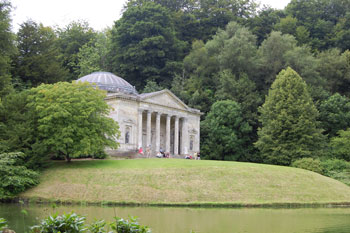Post Medieval AD 1485 - AD 1800
 By the 16th century middle-class yeomanry and landowners were emerging in the countryside. Shifts in landownership were also exacerbated by the dissolution of the monasteries in the 1530s which in the AONB saw the transfer of large swathes of land from ecclesiastical powers to noble magnates. Many field systems remained little altered in some areas until the 18th century, but elsewhere enclosure during the 15th and 16th centuries meant land use became more intensive. In some cases enclosures were informal, but in others they were forcible events dictated by Crown officials or wealthy landowners. Large areas of former arable land on the downs were converted to pasture, and increases in stock numbers led to shortages of late winter and early spring fodder.
By the 16th century middle-class yeomanry and landowners were emerging in the countryside. Shifts in landownership were also exacerbated by the dissolution of the monasteries in the 1530s which in the AONB saw the transfer of large swathes of land from ecclesiastical powers to noble magnates. Many field systems remained little altered in some areas until the 18th century, but elsewhere enclosure during the 15th and 16th centuries meant land use became more intensive. In some cases enclosures were informal, but in others they were forcible events dictated by Crown officials or wealthy landowners. Large areas of former arable land on the downs were converted to pasture, and increases in stock numbers led to shortages of late winter and early spring fodder.
From the 1600s systems of managed water meadows developed in many valley bottoms. These played a crucial role in Britain's farming economy between 1600 and 1900.This enabled much larger flocks of sheep to be sustained on downland fields.
By the 18th century informal, piecemeal enclosure had created a patchwork of small, irregularly shaped fields and winding lanes and tracks. This was especially the case in the Vale of Wardour. However large swathes of open chalk grassland remained. The process of enclosure escalated from 1750 as the downland was increasingly enclosed and converted to arable. This was formalized in a process known Parliamentary Enclosure which occurred in England mostly in the period between 1750 and 1850.
The beginnings of the large scale enclosure of the southern downlands of the AONB was captured by William Defoe in 1725
"But 'tis more remarkable still; how a great part of these downs comes by a new method of husbandry, to be not only made arable, which they never were in former days, but to bear excellent wheat, and great crops too"
From the later 18th century some areas of down pasture were converted to arable, and common woods, heaths and grasslands were also enclosed. The rectangular, regular patterns of field systems bounded by hedges on low field banks seen in many parishes today were the result of these later enclosures.
The increasing importance of polite estates for the aristocracy and rural gentry were also associated with the building of new, large houses or the refurbishment of existing ones. There was an increasing preference for more naturalistic designs, with irregular plantations and sweeping panoramic vistas.
Turnpikes built during this period represent the first systematic system of 'made' roads across the country since the Roman Road.
This document forms part of the wider AONB Historic Environment Action Plans.
